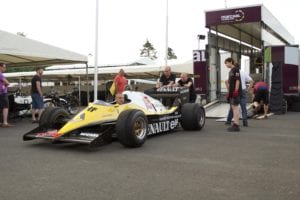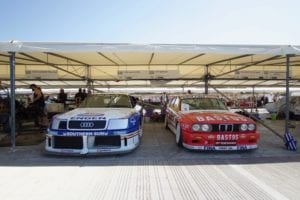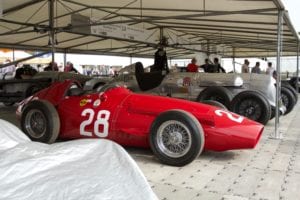The Greatest Garden Party on Earth

This year marked the 25th anniversary, or Silver Jubilee, of the Goodwood Festival of Speed, the ultimate garden-party celebration of motorsports history. In twenty-five short years, the festival has grown from a relatively small gathering to a grand celebration of the automobile amidst a legendary atmosphere.
“We really invented the Festival of Speed as the antidote to modern Formula 1,” says Doug Nye, famed automotive journalist and co-founder of the Goodwood Festival of Speed and the Goodwood Revival Meeting.
“When I was a kid as an enthusiast first going to races, I remember being able to walk around in the paddock, and you’d see the greats of the time like Jim Clark, Graham Hill and Jackie Stewart, and if you chose your moment you could say hello to them and you could talk to them and you could really look at the cars as close as we are here. But you can’t do that in modern Formula 1.” For Nye, the aim of the Festival of Speed has always been “to bring back some of that old-time accessibility.”
With access to the cars and drivers as the unofficial mission, one would expect that the gathering would be relatively small, with a collection of a few particularly significant Formula 1 cars and a laid-back atmosphere reminiscent of F1’s past. But that was most certainly not the case. While the relaxed, approachable attitude remains, the Festival of Speed has evolved over 25 years into a celebration of significant racing cars and motorcycles from across the spectrum of motorsport. Johnny Rutherford’s 1980 Indy 500-winning Chaparral, Vaughn Gittin Jr.’s Formula Drift Ford Mustang RTR, and Rod Millen’s Pikes Peak record-holding Toyota Celica all have a place at Goodwood.
“You’ve just got to look around to see the depth and scope of the cars,” says former Formula 1 driver and Sky Sports commentator Martin Brundle. “It brings the racing community together. Racing is a very cosmopolitan business, and I think this event underlines that.”
Revs Institute’s Gurney Eagle Mk. 1 F-1 race car was immensely popular throughout the weekend.In attendance from the Miles Collier Collections at Revs Institute were two special cars. First, the Rob Walker Racing Cooper T43, which won the 1958 Argentine Grand Prix at the hands of Stirling Moss, becoming the first rear-engined car in the modern Grand Prix era to win a race. Second, Dan Gurney’s Gurney-Weslake Eagle Mk. 1, which is considered to be one of the most beautiful Formula 1 cars of all time. The Eagle Mk.1 is also the first and only American car to win a modern Formula 1 race with an American driver, a feat achieved by Dan Gurney at the 1967 Belgian Grand Prix.
Revs Institute’s Cooper T43 in good company following Pink Floyd drummer Nick Mason’s Ferrari 250 GTO.Lord March personally invites each and every car, and he tends to invite different cars with different themes each year to keep the event fresh. This year’s theme was the return of the most popular cars in Goodwood’s history, and it was truly a showcase of the striking diversity of the cars that have participated in the twenty-five years of the Festival of Speed.
The “Batmobile” BMW 3.0 CSL. This one won its class at Le Mans in 1973 in the hands of Dieter Quester and Toine Hezemans.
Porsche celebrated its 70th anniversary at the 2018 Festival of Speed. Cars running up the hill at the Festival of Speed are sectioned into “batches,” and the organizers appropriately dedicated an entire batch to Porsche. From left to right in this photo, 910, Rothmans 962C, 956, 961, and the David Piper Racing 917.
Porsche’s display at the Festival of Speed was enormous. Here a 904/8 passes a unique Porsche 911 art car. The car is a 1966 short-wheelbase 911, race prepped by UK-based Tuthill Porsche. The striking livery is modeled after British fashion designer Paul Smith’s “Artist Stripe” pattern.
Martini Racing also celebrated its 50th anniversary at Goodwood. Here, a line of Martini Porsches with the infamous 935 “Moby Dick” in the immediate foreground.
Indycars were aplenty at FoS. Teo Fabi’s 1988 Indy 500 March 88P-Porsche V8 sat largely ignored throughout the weekend, presumably because it didn’t run up the hill.
Johnny Rutherford, three-time Indianapolis 500 champion, prepares for a run up the hill in the 1980 Chaparral 2K that won him his final Indy 500 victory and his only Indycar championship title. “Lone Star JR” seemed somewhat surprised when several people recognized him.
The Porsche Museum brought a large selection of race and road cars to Goodwood, including this 959 and 911 2.7 RS, to celebrate the marque’s 70th birthday in style.
A glimpse of the (possibly?) autonomous future at the Festival of Speed. Roborace, a British startup intent on creating the world’s first autonomous racing series, made headlines this year when its Robocar ran the first ever driverless hill climb at the Festival of Speed.
This Brawn BGP 001 also did not run up the hill, but the sparse tent drew attention nonetheless. The BGP 001 dominated the first few races of the 2009 season, due largely to its “double-decker diffusor.” In a classic case of loophole exploitation, Brawn GP, along with Williams and Toyota, converted the rear crash structure of the car into a second diffusor placed above the primary diffusor. Since the tents at the modern F1 paddock were roped off, the infamous diffusor was unfortunately out of view.
Renault Sport brought their factory historic squad to support two cars at the Festival of Speed. Above, Alain Prost’s 1983 RE40 is unloaded off a carrier on Thursday evening. This car narrowly missed out on the 1983 Formula 1 Championship because of a turbo failure during the critical final race of the season in South Africa.
Legendary F1 driver René Arnoux steps into his 1979 Renault RS01 before its run up the hill. This car was involved in the legendary Arnoux – Gilles Villeneuve battle for second position in the final laps of the 1979 French Grand Prix at Dijon-Prenois.
The “touring cars” section of the paddock was popular throughout the weekend. On the left is an Audi S4 GTO, designed to run in the then-premier South African racing series, the Wesbank Modifieds championship. On the right, a Group A BMW M3.
The Avions-Voisin C6 Laboratoire. While it looked somewhat home-built, designers Gabriel Voisin and André Lefèbvre’s backgrounds in aviation were evident in the car’s advanced aerodynamic design.
The Cartier Style et Luxe lawn featured some gems, including this Jaguar “Le Mans” by Michelotti. This car began life as D-Type chassis XKD 513, which crashed at the hands of Jean Marie Brousselet at Le Mans in 1958. Coachbuilder Giovanni Michelotti bought the chassis in 1960 and built the gorgeous coupe body seen on the car today.
Also on the Cartier lawn was this brawny Monteverdi High Speed 375 by Frua, the perfect car for a high speed run from Switzerland to Goodwood (Monteverdi is one of only a few Swiss automakers).
John Surtees’s 1964 Formula 1 championship-winning Ferrari 158 waiting for its turn at the hill. Allegedly, “Il Commendatore” Enzo Ferrari personally insisted that the car have its wheels painted in this striking shade of blue.
Rod Millen’s Pikes Peak Toyota Celica. This car holds the record at the Race to the Clouds from the pre-pavement era, before the entire course was paved in 2011. Next to it sits Georg Plasa’s Judd V8-powered BMW M3 which found success on the European hill climb circuit.
Modern supercars are popular at the Festival of Speed. This Apollo IE (which appropriately stands for “Intensa Emozione”) features a purple-tinted exposed carbon fiber body.
A Jaguar C-X75, of Bond film Spectre fame. Behind it is Ferrari’s most recent halo car, the LaFerrari.
Before Revs Institute’s Cooper T43 brought about the mid-engine revolution in open wheel racing, there was the Auto Union Type C with its 520 metric horsepower 6-liter V16 mounted amidships. The car featured at the Festival of Speed was a replica built for Audi by Crosthwaite & Gardiner on an original chassis, faithful to the specifications of the original car.
The red Fiat “Beast of Turin” S76, powered by a 28.5 liter 4 cylinder engine. It garnered a reputation for being “undrivable” in its day, and certainly seemed to be a handful on the hill.
The Jaguar E2A. Though considered to be an intermediate step between the D-Type and the E-Type, E2A actually shared little in common with either of them, and every panel was entirely unique. Dan Gurney, Jack Brabham, and Bruce McLaren all drove E2A in 1960, but found little success in international competition.
Very much at the other end of the automotive spectrum lay this Ford Mustang RTR, driven by Vaughn Gittin Jr. in the Formula Drift series.
This year’s Festival celebrated the lives of Dan Gurney, John Surtees, and Sir Stirling Moss, and all of their contributions to motor racing. Sir Stirling’s Maserati 250F looked absolutely magnificent throughout the weekend.
A makeshift champagne bar set up in the “bed” of a NASCAR Truck Series Toyota Tundra to celebrate 1995 NASCAR Truck champion Mike Skinner’s run in the timed shootout on Sunday afternoon.
Two famous Jaguar XK120s shared a booth at the Festival of Speed. The “Montlhéry Coupé” on the right was driven by Stirling Moss, Jack Fairman, and Bert Hadley at an average speed of 100.32 miles per hour for 7 days and nights in a row at the French Autodrome de Montlhéry in a bid to prove the XK’s reliability. The “NUB 120” on the left is considered to be the most successful XK120 ever, with countless rally victories between 1950 and 1951 including two consecutive Alpine Rally wins.
Jochen Mass stands with his 1987 500 kilometers of Kyalami-winning Porsche 962C. The car was bodied by Richard Lloyd Racing.


